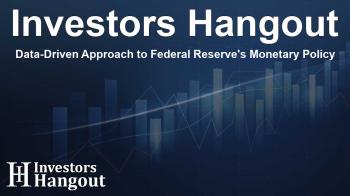Data-Driven Approach to Federal Reserve's Monetary Policy

Data-Driven Approach to Federal Reserve's Monetary Policy
By Michael S. Derby
The President of the Federal Reserve Bank of New York, John Williams, has recently emphasized that the future actions of monetary policy will reflect the analysis of economic data. Confronted by a particularly uncertain economic landscape, the central bank is cautious, largely due by possible shifts in government policy that could affect overall financial stability.
Balancing Risks Through Data
Williams remarked, "Monetary policy is well positioned to keep the risks to our goals in balance.” In a speech prepared for the CBIA Economic Summit and Outlook 2025, he underlined that the trajectory of monetary policy decisions would hinge on the robustness of economic data available at the time.
As the vice-chairman of the Federal Open Market Committee, Williams highlighted the challenges posed by government policy as significant factors complicating the economic projections. He reiterated the importance of staying informed: "The economic outlook remains highly uncertain, especially around potential fiscal, trade, immigration, and regulatory policies." This uncertainty is guiding the Fed's monetary policy decisions.
Monetary Policy Actions Under Scrutiny
In the latest Federal Reserve meeting, the policymakers adjusted the federal funds target rate, reducing it by a quarter percentage point to a range between 4.25% and 4.5%. Updated forecasts now reflect a more cautious approach, with lowered expectations for rate cuts this year and revised upward projections for inflation, primarily driven by persistent price pressures identified in recent economic data.
The possibility of Donald Trump returning to the presidential seat has created additional clouds over economic forecasts. His campaign has included promises of trade and immigration policy changes that many economists believe would likely inflame inflationary pressures, complicating the Federal Reserve's mandate to lower inflation back to its target of 2%.
Economic Balance Post-Pandemic Disruptions
Amidst these concerns, Williams expressed optimism about the current state of the economy, indicating that it has returned to a balanced state following the tumultuous impacts of the pandemic. He believes that the disinflationary process is ongoing; however, he cautions that achieving the 2% inflation target may not occur swiftly. Williams anticipates that this goal could be met “in the coming years.”
Moreover, he anticipates that the nation’s GDP growth will stabilize at around 2%, while the unemployment rate is expected to hover between 4% and 4.25%. These forecasts demonstrate a hopeful yet cautious outlook for the economy amid ongoing uncertainties.
Fed's Balance Sheet Adjustments
Williams also provided insights into the Federal Reserve's ongoing adjustments to its balance sheet, stating that the process has been proceeding smoothly. This stability in balance sheet management is essential as it supports the overarching goals of monetary policy, ensuring that the economic landscape remains conducive for growth and stability.
Frequently Asked Questions
What did John Williams emphasize about monetary policy?
John Williams emphasized that monetary policy decisions will be primarily driven by economic data due to uncertainty in the economic environment.
How has the Fed's target rate changed recently?
The Federal Reserve recently lowered their federal funds target rate range by a quarter percentage point, now set between 4.25% and 4.5%.
What are the implications of a possible Trump presidency on the economy?
A potential Donald Trump presidency may introduce trade and immigration policies likely to increase inflation, complicating the Federal Reserve’s efforts to meet its inflation target.
What is the Fed’s inflation target?
The Federal Reserve aims to maintain an inflation rate of around 2%, which has been a central goal of its monetary policy strategy.
What is John Williams' outlook for the economy?
Williams believes that the economy is currently balanced and expects GDP growth to moderate to about 2% with the unemployment rate remaining around 4% to 4.25%.
About The Author
Contact Kelly Martin privately here. Or send an email with ATTN: Kelly Martin as the subject to contact@investorshangout.com.
About Investors Hangout
Investors Hangout is a leading online stock forum for financial discussion and learning, offering a wide range of free tools and resources. It draws in traders of all levels, who exchange market knowledge, investigate trading tactics, and keep an eye on industry developments in real time. Featuring financial articles, stock message boards, quotes, charts, company profiles, and live news updates. Through cooperative learning and a wealth of informational resources, it helps users from novices creating their first portfolios to experts honing their techniques. Join Investors Hangout today: https://investorshangout.com/
The content of this article is based on factual, publicly available information and does not represent legal, financial, or investment advice. Investors Hangout does not offer financial advice, and the author is not a licensed financial advisor. Consult a qualified advisor before making any financial or investment decisions based on this article. This article should not be considered advice to purchase, sell, or hold any securities or other investments. If any of the material provided here is inaccurate, please contact us for corrections.

